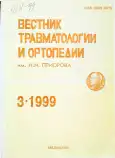Compartment syndrome in patients with surgical pathology
- Authors: Nazarenko G.I.1, Kanyuchevsky A.B.1, Minasyan A.M.1, Arablinsky A.V.1, Kuchin G.A.1
-
Affiliations:
- Medical Center of the Central Bank of Russia
- Issue: Vol 6, No 3 (1999)
- Pages: 3-11
- Section: Original study articles
- URL: https://bakhtiniada.ru/0869-8678/article/view/105090
- DOI: https://doi.org/10.17816/vto105090
- ID: 105090
Cite item
Full Text
Abstract
Compartment syndrome (CS) combines different clinical conditions of organs and tissues blood supply disturbance with the closed space. Evolution of CS results from progressively increasing intraspace pressure which may cause the hemodynamic disorders in organs and tissues isolated within the space. Two main mechanisms of increased pressure are distinguished: decrease of space volume with unchanged volume of contents (e.g. as a result of localized external pressure) or increase of contents volume in the space. In clinical practice two types of CS are found most frequently: muscular-fascial and abdominal. Muscular-fascial CS evolves in the muscular-fascial space under increased pressure that evokes compression of vascular-nervous structures. Increase of intra-abdominal pressure is a mechanism of the CS evolution. Delay in diagnosis as well as the delay in operative intervention may result in severe complications, especially in elderly patients with a great number of concomitant diseases. In the same time severe complications of CS can be prevented by timely diagnosis and decompression of fascial spaces using minimum invasive surgical interventions, i.e. fasciotomies.
Keywords
Full Text
##article.viewOnOriginalSite##About the authors
G. I. Nazarenko
Medical Center of the Central Bank of Russia
Author for correspondence.
Email: info@eco-vector.com
Russian Federation, Moscow
A. B. Kanyuchevsky
Medical Center of the Central Bank of Russia
Email: info@eco-vector.com
Russian Federation, Moscow
A. M. Minasyan
Medical Center of the Central Bank of Russia
Email: info@eco-vector.com
Russian Federation, Moscow
A. V. Arablinsky
Medical Center of the Central Bank of Russia
Email: info@eco-vector.com
Russian Federation, Moscow
G. A. Kuchin
Medical Center of the Central Bank of Russia
Email: info@eco-vector.com
Russian Federation, Moscow
References
- Alusio F.V., Christensen С.Р., Urbaniak J.R. Orthopaedics. — 2nd ed. —Baltimore; New York; London, 1997. — P. 90-95.
- Callaham M.L. Curent therapy in emergency medicine.— Toronto; Philadelphia, 1987. — P. 883-884.
- DeMar M.A., Granberg J.C. //J. Laparoendosc. Surg.— 1995. — Vol. 5, N 2. — P. 71-76.
- Meldrum D.R., Moore F.A., Moore E.E. et al. //Am. J. Surg. — 1997. — Vol. 174, N 6. — P. 667-673.
- Moore E.E., Burs J.M., Franciose R.J. et al. //Word J. Surg. — 1998. — Vol. 22. — P. 1184-1191.
- Pousada L., Osborn H.H., Levy D.B. Emergency Medicine. — 2nd ed. —Baltimore; New York; London, 1996. — P. 419-420; 495-496; 583-587.
- Schein M., Wittman D.H. //Complications in Surg. — 1996. — Vol. 15, N 5.
Supplementary files












